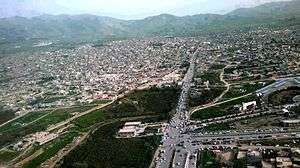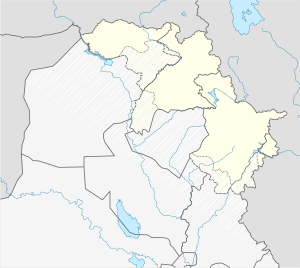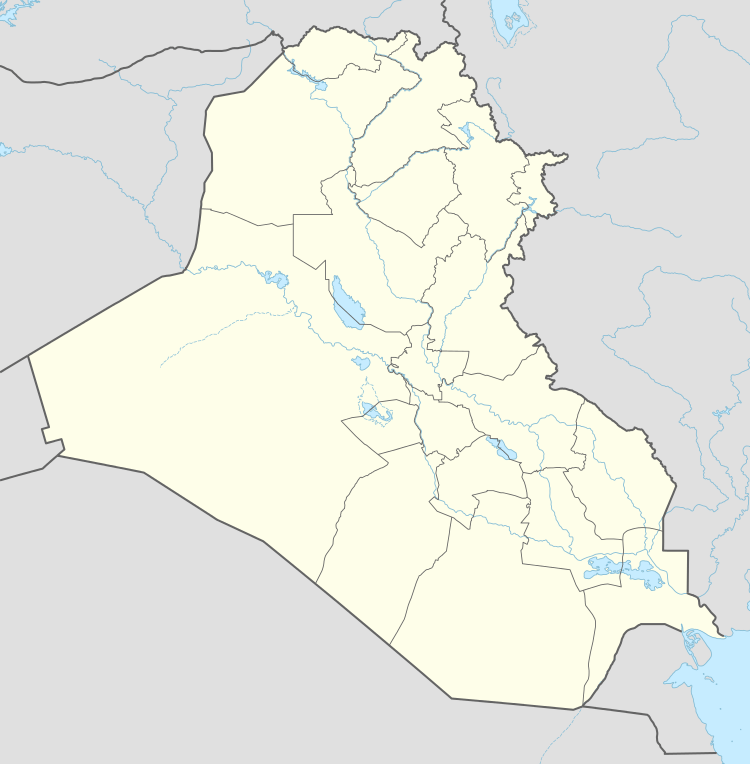Halabja
Halabja (Kurdish: هەڵەبجە, Helebce) is a city in Kurdistan Region and the capital of Halabja Governorate, located in Iraq about 240 km (150 mi) northeast of Baghdad and 14 km (9 mi) from the Iranian border.
Halabja Kurdish: هەڵەبجە Arabic: حلبجة | |
|---|---|
City | |
 Halabja city | |
 Halabja Halabja in Iraq  Halabja Halabja (Iraq) | |
| Coordinates: 35°11′11″N 45°58′26″E | |
| Country | |
| Autonomous region | |
| Governorate | Halabja |
| Established | 1650 BC |
| Government | |
| • Mayor | Nuxsha Nasih |
| Area | |
| • Total | 1,600 km2 (600 sq mi) |
| Elevation | 900 m (3,000 ft) |
| Population (2018) | |
| • Total | 245,700[2] |
| Time zone | UTC+3 |
The city lies at the base of what is often referred to as the greater Hewraman region stretching across the Iran–Iraq border. Halabja is surrounded by Hawraman and Shnrwe range in the northeast, Balambo range in the south and Sirwan river in the west. The Kurds in the city of Halabja generally speak only the Sorani dialect of Kurdish, but some residents of the surrounding villages speak the Hewrami dialect.
History
Early history
Halabja has a long history, as proven by excavations at nearby archaeological sites like Bakr Awa. The cemetery includes the tombs of several historical figures, such as Ahmed Mukhtar Jaff, Tayar Bag Jaff and Adila Khanim. In August 2009, three 17th century tombs were discovered in the Ababile district of the town.[3]
This suggests that the town is somewhat older than indicated by some sources, which claim that it was built by the Ottoman Empire at about 1850. However, modern developments date from the early 20th century. The post office opened in 1924 and the first school opened the following year. The Qaysari Pasha and Hamid Bag bazaars were built-in 1932. Electricity did not reach the city until 1940.[4]
At the beginning of the 20th century, there were many British soldiers stationed in Halabja. During World War I, Adela Khanum saved the lives of several British soldiers, resulting in the British honoring her with the title Khan Bahadur, Princess of the Brave. She was also responsible for the building of a new prison, setting up a court of justice, of which she was the first president and building a new bazaar.[5]
During the Al-Anfal campaign of the Iraqi Government, which took place between March 1987 and May 1989, the neighborhoods Kani Ashqan and Mordana were erased in May 1987 as a reprisal for the support of the Peshmerga.[6] But Halabja suffered much more during the Al-Anfal campaign, in which Saddam Hussein violently suppressed Kurdish revolts during the Iran–Iraq War.
Chemical attack
The Kurdish peshmerga guerrillas, supported by Iran, captured Halabja in the final phase of the Iran–Iraq War. At 11:00 AM, On March 16, 1988, after two days of conventional artillery attacks, Iraqi planes dropped gas canisters on the town.[7][8] The town and surrounding district were attacked with bombs, artillery fire and chemical weapons, the last of which proved most devastating. At least 5,000 people died as an immediate result of the chemical attack and it is estimated that a further 7,000 people were injured or suffered long-term illness.[9] Most of the victims of the attack on the town of Halabja were Kurdish civilians.[10]
The attack is believed to have included the nerve agents Tabun, Sarin and VX, as well as mustard gas. However, according to former senior CIA analyst Stephen C. Pelletiere, Iraq did not have the nerve agent used in the attack but did have mustard gas which was used in the Iran–Iraq War. An interdisciplinary scientific study from 2019, after more than three decades, shows that the chemical attacks on Halabja have long-term biological, psychological and social effects on the survivors. The authors, Faraidoun Moradi, Mia Söderberg, Fazil Moradi and others conclude: "The post-exposure somatic and psychosocial effects such as respiratory symptoms of CWA are a plausible contributors to poor general health and quality of life among survivors. We conclude that multidisciplinary interventions are needed to tackle the biopsychosocial complications in survivors of SM exposure to minimize further health damage in the future, as well as to promote their health-related quality of life."[11]
It is occasionally suggested[12] that cyanide was also included among these chemical weapons, though this assertion has been cast into doubt, as cyanide is a natural byproduct of impure Tabun.[13]
Before the war ended the Iraqis moved in on the ground and completely destroyed the town.[14] In March 2010, the Iraqi High Criminal Court recognized the Halabja massacre as genocide; the decision was welcomed by the Kurdistan Regional Government.[15]
Kurdish autonomy
In the mountains to the west of Halabja, a militant Islamist group, Ansar al-Islam, occupied a small enclave in the period of 2000–2003. The area was overrun by Peshmerga forces from the Patriotic Union of Kurdistan (PUK), with U.S. air support, at the beginning of the 2003 invasion of Iraq. The town has remained a center of Islamism in the Kurdistan region, however.
Just before Kurds gained some autonomy over the Iraqi Kurdistan region in 1991, which included Halabja, a new town was set up where some former Kurdish refugees later relocated. The new town called Halabja Taza (or New Halabja) today has an estimated 9,000 homes.[16]
The Kurdistan Regional Government made some concentrated reconstruction efforts after 2003 in the old town and began rebuilding some of the bombed-out homes in Halabja and paving new roads. A memorial was also constructed for the victims of the chemical attacks. However, residents of Halabja have complained about the continued lack of basic services and necessities.[17]
On the 2006 anniversary of the gas attack, violent demonstrations erupted in Halabja. An estimated 7,000 demonstrators protested against priorities in reconstruction, claiming that officials were not sincerely addressing the problems of the gas attack victims. Roadblocks were set up and the gas attack memorial museum was set afire. Police fired at protesters killing one 14-year-old boy and wounding many others.[18]
Climate
Halabja has a hot-summer Mediterranean climate (Csa) with very hot summers and cool wet winters.
| Climate data for Halabja | |||||||||||||
|---|---|---|---|---|---|---|---|---|---|---|---|---|---|
| Month | Jan | Feb | Mar | Apr | May | Jun | Jul | Aug | Sep | Oct | Nov | Dec | Year |
| Average high °C (°F) | 9.6 (49.3) |
11.8 (53.2) |
16.9 (62.4) |
22.0 (71.6) |
29.5 (85.1) |
35.8 (96.4) |
39.6 (103.3) |
39.2 (102.6) |
35.0 (95.0) |
28.4 (83.1) |
19.7 (67.5) |
12.5 (54.5) |
25.0 (77.0) |
| Daily mean °C (°F) | 4.8 (40.6) |
6.6 (43.9) |
11.2 (52.2) |
15.8 (60.4) |
22.0 (71.6) |
27.4 (81.3) |
31.2 (88.2) |
30.8 (87.4) |
26.4 (79.5) |
20.5 (68.9) |
13.3 (55.9) |
7.3 (45.1) |
18.1 (64.6) |
| Average low °C (°F) | 0.1 (32.2) |
1.4 (34.5) |
5.6 (42.1) |
9.7 (49.5) |
14.5 (58.1) |
19.0 (66.2) |
22.8 (73.0) |
22.5 (72.5) |
17.9 (64.2) |
12.7 (54.9) |
7.0 (44.6) |
2.2 (36.0) |
11.3 (52.3) |
| Average precipitation mm (inches) | 144 (5.7) |
146 (5.7) |
132 (5.2) |
85 (3.3) |
35 (1.4) |
0 (0) |
0 (0) |
0 (0) |
0 (0) |
28 (1.1) |
79 (3.1) |
124 (4.9) |
773 (30.4) |
| Source: [21] | |||||||||||||
References
- "The Kurdistan Region in brief". cabinet.gov.krd.
- "Ḩalabjah - to view map". www.geonames.org.
- "Ancient tombs found in Halabja". AK News. 9 August 2008. Archived from the original on 21 August 2009. Retrieved 7 September 2009.
- "History of Halabja". PUK media. 16 March 2009. Archived from the original on 3 October 2011. Retrieved 7 September 2009.
- "Adela Khanum – Princess of the Brave". Kurdistan's Women. 4 April 2008. Retrieved 7 September 2009.
- Committee, Human Rights Watch Middle East Watch; Staff, Middle East Watch; Black, George; Watch (Organization), Middle East (1993). Genocide in Iraq: The Anfal Campaign Against the Kurds. Human Rights Watch. p. 103. ISBN 9781564321084.
- "Remembering Victims of Genocide: The Chemical Attack on Halabja 1988". Rudaw.
- "1988: Thousands die in Halabja gas attack". BBC News. 16 March 1988. Retrieved 4 May 2010.
- Osman, Hiwa (17 March 2002). "Iraqi Kurds recall chemical attack". BBC News. Retrieved 5 August 2006.
- "Whatever Happened To The Iraqi Kurds?". Human Rights Watch. 11 March 1991.
- Moradi, Faraidoun; Söderberg, Mia; Moradi, Fazil; Daka, Bledar; Olin, Anna-Carin; Lärstad, Mona (21 June 2019). "Health perspectives among Halabja's civilian survivors of sulfur mustard exposure with respiratory symptoms—A qualitative study". PLOS ONE. 14 (6): e0218648. doi:10.1371/journal.pone.0218648. ISSN 1932-6203. PMC 6588230. PMID 31226143.
- "Facts About Cyanide". Centers for Disease Control. Archived from the original on 15 April 2010.
- "Iraq events – Chemical warfare". BBC News. Retrieved 4 May 2010.
- Hirst, David (22 March 1988). "The Kurdish victims caught unaware by cyanide". The Guardian. London. Retrieved 9 June 2006.
- AK News, 1 March 2010 Archived 20 March 2011 at the Wayback Machine
- Dagher, Sam. Uprooted for Decades, Iraqi Kurds Long for Home. Halabja Taza Journal. NY Times, 3 September 2009
- "Mohammad, Susan. Revisiting the horror of Halabja. The Ottawa Citizen, 22 October 2007". canada.com. Archived from the original on 12 April 2009.
- "BBC NEWS – Middle East – Kurdish clash at Halabja memorial". bbc.co.uk.
- "International Airport to be built in Halabja town ( K Sat)". Independent Kurdistan Journalism. 16 July 2008. Retrieved 7 September 2009.
- "M 7.3 - 30km SW of Halabjah, Iraq". earthquake.usgs.gov. Retrieved 12 November 2017.
- "Climate statistics for Halabja". Bureau of Meteorology. Retrieved 21 January 2017.
External links
![]()